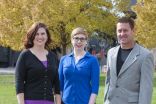(Press-News.org) A survey of more than 300 college students reveals that college students who use "fake weed" or synthetic THC are most likely to have tried the drug because they were curious. Rebecca Vidourek, a University of Cincinnati assistant professor of health promotion and assistant director of the Center for Prevention Science; Keith King, a UC professor of health promotion and director of the Center for Prevention Science; and Michelle Burbage, a graduate student and graduate assistant for UC's Health Promotion and Education Program, published their findings in the current issue of the Journal of Drug Education.
The study found that 17 percent of the students surveyed reported taking synthetic THC at least once in their lifetime. Three percent of those surveyed had reported recent use. "Based on the study's findings, it appears senior year of high school and the first year of college is the primary time for initiating use of THC," write the authors of the study. "Perhaps, targeting middle and high school students with education programs on the negative effects of THC is needed to prevent initiation and regular use."
Tetrahydrocannabinol, or THC, is the chemical compound that is naturally produced in the cannabis or marijuana plant that results in the relaxation or "high" effect of marijuana users. Synthetic THC - sold under street names such as K2, fake weed, herbal incense, plant food, spice and other names - is produced with chemicals to mimic the effects of THC in the natural form of marijuana. The National Institute on Drug Abuse reports that the lab chemicals most commonly found in synthetic THC have been defined by the Drug Enforcement Agency as Schedule 1 controlled substances.
However, these lab-manufactured drugs are easy to get, hard to spot in drug tests, and, as a result, they're becoming increasingly popular among young people. The authors say previous research on the use of synthetic THC has centered on the high-school population with limited research on its use among college students.
The authors distributed a three-page survey that was completed by 338 students in undergraduate and graduate health programs at a public university.
The survey found that the majority of the survey participants had not used synthetic THC - 17.1 percent of respondents reported using synthetic THC at least once in their lifetime. The study's authors report that of those who had tried THC, 19.2 percent reported curiosity as the top reason for trying the substance; 17.4 percent reported using the drug for the purpose of getting high and 10.6 percent reported that the "fun of feeling high" was the main factor contributing to use.
The authors also report that 4 percent had tried THC to "fit in," and 3.8 percent felt they were peer-pressured into trying the drug.
The majority of students who had used the drug also reported that head shops - retail outlets that sell items such as tobacco products, bongs, roach clips and other casual drug-related paraphernalia - were popular places to purchase synthetic THC, followed by friends, tobacco shops, hemp shops, the Internet, gas stations, convenience stores and other locales.
The survey also turned up students reporting negative side effects from using THC, including racing heartbeat, nervousness, paranoia, nausea and headaches.
Study Demographics
The survey sample was just over 59.2 percent female (200 students) and 40.8 percent male (138 students), with ages ranging from 18 to 36. Eighty-one percent of the participants where white; 7.7 percent were African-American; 6 percent were Asian; 3.3 percent identified as "other"; and 1.5 percent reported being Hispanic. The sample included students ranging from freshmen to graduate students.
Researchers found no significant differences in drug use based on when they first tried THC. However, the survey indicated that females were more likely to try the drug at a significantly younger age (17.8) than males (18.4). The majority of freshmen and sophomores in the survey who had tried THC began using when they were just over 16 ½. Juniors, seniors and grad students reported a later initiation age of 18.82 years.
INFORMATION:
The Journal of Drug Education is a quarterly academic journal that has examined all aspects of drug education for more than four decades.
The researchers in UC's Health Promotion and Education Program and Center for Prevention Science regularly present papers at professional meetings and publish in top-tiered professional journals throughout the profession. The program is in UC's College of Education, Criminal Justice, and Human Services.
This news release is available in French. "Media reports about behavioural genetics unintentionally induce unfounded beliefs, therefore going against the educational purpose of scientific reporting," writes the University of Montreal's Alexandre Morin-Chassé, following his study of 1,500 Americans. "Among other things, we wanted to know if the public understood (or misunderstood) popular science articles about a new research field, genopolitics, and whether this popularization indeed helped people have an informed opinion on human genetics," Morin-Chassé explained.
The ...
This news release is available in German. The ways animals play with inedible objects may be precursors of functional behaviors such as tool use and goal directed object manipulation. For these reasons, species of high technical intelligence are also expected to play intensely with inanimate objects when no obvious goal is pursued. Within object play, combinatory actions are considered a particularly informative trait in animals as well as human infants: Children start bashing two objects together when they are about 8 months old, at 10 months, they combine toys with ...
A study conducted by University of Granada scientists (from the Physiology, Obstetrics and Gynaecology Departments) and from the San Cecilio Clinical Hospital (Granada) has demonstrated that delaying the cutting of the umbilical cord in newborns by two minutes leads to a better development of the baby during the first days of life.
This multidisciplinary work, published in the prestigious journal Pediatrics reveals that the time in cutting the umbilical cord (also called umbilical cord clampling) influences the resistance to oxidative stress in newborns.
For this research, ...
In medicine, X-rays provide high-resolution images of our insides to help doctors make a definitive diagnosis. Industry uses X-rays, too - as a reliable, non-destructive way of seeing what's hidden on inside materials and components and to check for cracks or irregularities. However industry additionally draws upon different technologies that are not used in the medical field. Whereas medical X-ray machines have been specifically designed for human test subjects, industrial X-ray machines are used to analyze objects that vary much more in their size and material composition. ...
MANHASSET, NY -- Molecular Medicine, a peer-reviewed biomedical journal published by the Feinstein Institute Press, published the results of a new study reporting clinically significant pain reduction in type 2 diabetic patients. In an exploratory study conducted by Araim Pharmaceuticals, a biotech company developing novel treatments for chronic diseases, investigators also observed improvements in metabolic control in patients administered ARA 290. ARA 290 is a peptide engineered to activate the innate repair receptor, a receptor discovered by Araim scientists, which is ...
Scientists at Johannes Gutenberg University Mainz (JGU) in Germany have discovered a new signal pathway in the brain that plays an important role in learning and the processing of sensory input. It was already known that distinct glial cells receive information from neurons. However, it was unknown that these same glial cells also transmit information to neurons. The glia release a specific protein fragment that influences neuronal cross-talk, most likely by binding to the synaptic contacts that neurons use for communication. Disruption of this information flow from the ...
New research led by the University of Exeter has found that people who have a stronger sense of place at the global than the national level are more likely to accept that climate change is caused by human activities. This is the first time that acceptance of human causes of climate change has been shown to be linked to people's sense of place at the global level. The findings have significant implications both for climate change communications and for our understanding of place and identities.
The study 'My country or my planet? Exploring the influence of multiple place ...
BLOOMINGTON, Ind. -- Scientists at Indiana University and colleagues at Stanford and the University of Texas have demonstrated a technique for "editing" the genome in sperm-producing adult stem cells, a result with powerful potential for basic research and for gene therapy.
The researchers completed a "proof of concept" experiment in which they created a break in the DNA strands of a mutant gene in mouse cells, then repaired the DNA through a process called homologous recombination, replacing flawed segments with correct ones.
The study involved spermatogonial stem ...
Patients with Parkinson's, medics and carers have identified the top ten priorities for research into the management of the condition in a study by the University of East Anglia and Parkinson's UK.
Commissioned by Parkinson's UK, people with direct and indirect personal experience of the condition worked together to identify crucial gaps in the existing evidence to address everyday practicalities in the management of the complexities of Parkinson's. Patients stated that the overarching research aspiration was an effective cure for Parkinson's but whilst waiting for this ...
DALLAS - Dec. 15, 2014 - UT Southwestern Medical Center neurology researchers have identified an important cell signaling mechanism that plays an important role in brain cancer and may provide a new therapeutic target.
Researchers found that this mechanism -- a type of signaling termed constitutive or non-canonical epidermal growth factor receptor (EGFR) signaling -- is highly active in glioblastomas, the most common type of adult brain cancer and a devastating disease with a poor prognosis.
When activated in cancer cells, it protects the tumor cells, making them more ...



